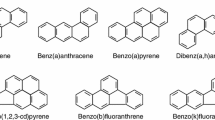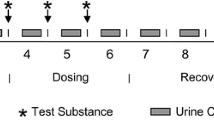Summary
Adequate stores and adequate tissue levels of vitamin A are maintained by a balance of tissue demands and dietary intake of the vitamin and are modified by many factors, including xenobiotics. It is well established that exposure to polyhalogenated aromatic hydrocarbons (PHAH) decreases hepatic content of vitamin A. Recent findings indicate that hepatic depletion of vitamin A is accompanied by an increase in serum and renal vitamin A content and enhanced excretion of vitamin A metabolites in urine and feces. Examination of tissue retinoid profiles reveals that PHAH exposure causes the generation of increased amounts of polar retinoids. It is very likely that PHAH affect enzymes crucial for regulation of vitamin A storage as well as enhance activities of specific enzymes in vitamin A metabolic pathway.
Zusammenfassung
Ausreichende Vitamin-A-Speicher und -Gewebslevel werden durch ein Gleichgewicht von Nachfrage der Gewebe nach Vitamin A und der Vitamin-A-Aufnahme durch die Nahrung aufrechterhalten und durch viele Faktoren beeinflußt.
Es ist hinreichend bekannt, daß polyhalogenierte aromatische Kohlenwasserstoffe (PHAH) die Vitamin-A-Speicher der Leber erniedrigen. Neuere Untersuchungen deuten darauf hin, daß die Erniedrigung der Vitamin-A-Leberspeicher von einem Anstieg des Vitamin-A-Gehaltes in Serum und Niere sowie von einer erhöhten Abgabe von Vitamin-A-Metaboliten in Urin und Fäzes begleitet sind. Die Untersuchung der Vitamin-A-Verteilung in verschiedenen Geweben zeigte, daß die Zufuhr von PHAH zu einem verstärkten Auftreten polarer Vitamin-A-Metaboliten führt. Es ist wahrscheinlich, daß die PHAH Enzyme beeinflussen, die entscheidend für die Regulation von Vitamin-A-Speichern sowie der Aktivität von für den Vitamin-A-Stoffwechsel wichtigen Enzymen sind.
Similar content being viewed by others
References
Akoso BT, Sleight SD, Aust SD, Stowe HD (1982) Pathological effects of purified polybrominated biphenyl congeners in rats. J Amer Coll Toxicol 1:1–21
Aust SD (1984) On the mechanism of anorexia and toxicity of TCDD and related compounds. In: Poland A, Kimbrough RD (eds) Banbury Report 18. Biological Mechanisms of Dioxin Action. Cold Spring Harbor Laboratory, pp 309–318
Bank PA, Zile MH (1989) Effect of 3,4,5,3′,4′,5′-hexabromobiphenyl (HBB) on cytochrome P-450 mediated retinoic acid metabolism. FASEB Journal 3 (Abs)
Bank PA, Salyers KL, Zile MH (1988) Effect of tetrachlorodibenzo-p-dioxin (TCDD) on the glucuronidation of retinoic acid in the rat (Submitted)
Bank PA, Cullum ME, Jensen RK, Zile MH (1989) Effect of hexachlorobiphenyl on vitamin A homeostasis in the rat. Biochim Biophys Acta (in press)
Brouwer A, Van den Berg KJ, Kukler A (1985) Time and dose responses of the reduction in retinoid concentrations in C57BL/Rij and DBA/2 mice induced by 3,4,3′,4′-tetrachlorobiphenyl. Toxicol Appl Pharmacol 78:180–189
Brouwer A, Van den Berg KJ (1986) Binding of a metabolite of 3,4,3′,4′-tetrachlorobiphenyl to transthyretin reduces serum vitamin A transport by inhibiting the formation of the protein complex carrying both retinol and thyroxin. Toxicol Appl Pharmacol 85:301–312
Cullum ME, Zile MH (1985) Acute polybrominated biphenyl toxicosis alters vitamin A homeostasis and enhances degradation of vitamin A. Toxicol Appl Pharmacol 81:177–181
Cullum ME, Zile MH (1985) Metabolism of all-trans-retinoic acid and all-trans-retinyl acetate. Demonstration of common physiological metabolites in rat small intestinal mucosa and circulation. J Biol Chem 260:10590–10596
Cullum ME, Zile MH (1986) Quantitation of biological retinoids by highpressure liquid chromatography: primary internal standardization using tritiated retinoids. Anal Biochem 153:23–32
Czuczwa JM, McVeety BD, Hites TA (1984) Polychlorinated dibenzo-p-dioxins and dibenzofurans in sediments from Siskiwit Lake, Isle Royale. Science 226:568–569
Dannan GA, Sleight SD, Aust SD (1982) Toxicity and microsomal enzyme induction effects of several polybrominated biphenyls of Firemaster. Fund Appl Toxicol 2:313–321
Darjano, Sleight SD, Stowe HD, Aust SD (1983) Vitamin A status, polybrominated biphenyl (PBB) toxicosis, and common bile duct hyperplasia in rats. Toxicol Appl Pharmacol 71:184–193
Dunckel AH (1975) An updating of the polybrominated biphenyl disaster in Michigan. J Am Vet Med Assoc 167:838–841
Firestone D (1984) Chlorinated aromatic compounds and related dioxins and furans: production, uses and environmental exposure. In: Poland A, Kimbrough RD (eds); Banbury Report 18. Biological Mechanisms of Dioxin Action; pp 3–16; Cold Spring Harbor Laboratory
Frolik CA (1984) Metabolism of retinoids. In: Sporn MB, Roberts AB, Goodman DS (eds); The Retinoids; pp 177–208; Academic Press Inc, New York
Goldstein JA, Hardwick J (1984) Regulation of a multigene family of P-450 isozymes by 2,3,7,8-tetrachlorodibenzo-p-dioxin and related compounds. In: Poland A, Kimbrough RD (eds); Banbury Report 18. Biological Mechanisms of Dioxin Action; pp 119–133, Cold Spring Harbor Laboratory
Hakansson H, Ahlborg UG (1985) The effect of 2,3,7,8-tetrachlorodibenzo-pdioxin (TCDD) on the uptake, distribution and excretion of a single oral dose of [11,12-3H]retinyl acetate and on the vitamin A status in the rat. J Nutr 115:759–771
Hakansson H, Ahlborg UG, Gottling L (1986) The effect of 2,3,7,8-tetrachlorodibenzo-p-dioxin (TCDD) on the distribution and excretion of the endogenous pool of vitamin A in rats with low liver vitamin A stores. Chemosphere 15:1715–1723
Innami S, Nakamura A, Kato K, Miyazaki M (1975) Polychlorinated biphenyls toxicity and nutrition. IV. PCBs toxicity and vitamin A. Fukuoka Acta Med 66:579–584.
Innami S, Nakamura A, Miyazaki M, Nagayama S, Nishide E (1976) Further studies on the reduction of vitamin A content in the livers of rats given polychlorinated biphenyls., J Nutr Sci Vitaminol 22:409–418
Jensen RK, Cullum ME, Deyo J, Zile MH (1987) Vitamin A metabolism in rats chronically treated with 3,3′,4,4′,5,5′-hexabromobiphenyl. Biochim Biophys Acta 926:310–320
Jensen RD, Zile MH (1988) Effect of dietary retinoic acid on circulatory vitamin A homeostasis in polybrominated biphenyl-treated rats. J Nutr 118:416–419
Kimbrough RD (1974) The toxicity of polychlorinated polycyclic compounds and related compounds. Crit Rev Toxicol 2:445–489
Kimbrough RD (1984) Skin lesions in animals and humans: A brief overview. In: Poland A, Kimbrough RD (eds), Banbury Report 18, Biological Mechanisms of Dioxin Action, pp. 357–363; Cold Spring Harbor Laboratory
Madden K (1987) Nightmare on Oakwood Drive: PCB cloud descends on dinner. Article in Towne Courier, a Community Newspaper serving East Lansing, MI, Haslett, MI and Okemos, MI (Wednesday, August 12). Accidental PBB release in environment in Ottawa Canada, August 24, 1988
Narbonne JF (1979) Toxicol Eur Res 2:41–45
Nebert DW, Gonzalez FJ (1987) P-450 genes: structure, evolution and regulation. Ann. Rev. Biochem. 56:945–993
Owens IS (1977) Genetic regulation of UDP-glucuronosyltransferase induction by polycyclic aromatic compounds in mice. J. Biol. Chem. 252:2827–2833
Peterson RE, Seefeld MD, Christian BJ, Potter CL, Kelling CK, Keesey RE (1984) The wasting syndrome in 2,3,7,8-tetrachlorodibenzo-p-dioxin toxicity: basic features and their interpretation. In: Poland A, Kimbrough RD (eds.), Banbury Report 18. Biological Mechanisms of Dioxin Action, pp. 291–308; Cold Spring Harbor Laboratory
Poland A, Knutson JD (1982) 2,3,7,8-tetrachlorodibenzo-p-dioxin and related halogenated aromatic hydrocarbons: examinations of the mechanism of toxicity. Annu. Rev. Pharmacol. Toxicol. 22:517–554
Powers RH, Gilbert LC, Aust SD (1987) The effect of 3,4,3′,4′-tetrachlorobiphenyl on plasma retinol and hepatic retinyl palmitate hydrolase activity in female Sprague-Dawley rats. Toxicol Appl Pharmacol 89:370–377
Thunberg T, Ahlborg UG, Johnsson H (1979) Vitamin A (retinol) status in the rat after a single oral dose of 2,3,7,8-tetrachlorodibenzo-p-dioxin. Arch Toxicol 42:265–274
Thunberg T, Ahlborg UG, Hakansson H, Krantz C, Monier M (1980) Effect of 2,3,7,8-tetrachlorodibenzo-p-dioxin on the hepatic storage of retinol in rats with different dietary supplies of vitamin A (retinol). Arch. Toxicol. 45:273–285
Thunberg T (1983) The effect of TCDD on vitamin A in the kidney of normal and in vitamin A-deficient rats. Chemosphere 12:577–580
Thunberg T, Hakansson H (1983) Vitamin A (retinol) status in the Gunn rat. The effect of 2,3,7,8-tetrachlorodibenzo-p-dioxin. Arch Toxocol 53:225–233
Thunberg T (1983) Studies on the effect of 2,3,7,8-tetrachlorodibenzo-p-dioxin on vitamin A: A new aspect concerning mechanism of toxicity. Ph D Thesis, Dept Toxicology, Karolinska Institute, Stockholm, Sweden.
Thunberg T (1984) Effect of TCDD on vitamin A and its relation to TCDD-toxicity. In: Poland A, Kimbrough RD (eds) Banbury Report 18. Biological Mechanisms of Dioxin Action. Cold Spring Harbor Laboratory, pp 333–344
Thunberg T, Ahlborg UG, Wahlstrom B (1984) Comparison between the effects of 2,3,7,8-tetrachlorodibenzo-p-dioxin and six other compounds on the vitamin A storage, the UDP-glucuronosyltransferase and the aryl hydrocarbon hydroxylase activity in the rat liver. Arch Toxicol 55:16–19
Van Putten LM, Van Bekkum DW, DeVries MJ (1970) A severe chronic intoxication in a monkey colony. In: Balner H, Beveridge WIB (eds), Infection and Immunosuppression in Subhuman Primates, pp 155–1266; Munksgaard, Copenhagen
Villeneuve DC, Clark ML, Clegg DJ (1971) Effects of PCB administration on microsomal enzyme activity in pregnant rabbits. Bull Environ Contamin Toxicol 2:120–128
Wolff MS, Anderson HA, Selikoff IJ (1982) Human tissue burdens of halogenated aromatic chemicals in Michigan. J Amer Med Assoc 247:2112–2116
Zile MH, Schnoes HK, DeLuca HF (1980) Characterization of retinoyl B-glucuronide as a minor metabolite of retinoic acid in bile. Proc Natl Acad Sci USA 77:3230–3233
Zile MH, Inhorn RC, DeLuca HF (1982) Metabolites of all-trans-retinoic acid in bile: Identification of all-trans- and 13-cis-retinoyl glucuronides. J Biol Chem 257:3537–3543
Author information
Authors and Affiliations
Additional information
Herrn Prof. Dr. med. Karl Heinz Bässler zum 65. Geburtstag gewidmet
Rights and permissions
About this article
Cite this article
Zile, M.H., Bank, P.A. & Roltsch, I.A. Alterations in vitamin A metabolism by polyhalogenated aromatic hydrocarbons. Z Ernährungswiss 28, 93–102 (1989). https://doi.org/10.1007/BF02030126
Received:
Published:
Issue Date:
DOI: https://doi.org/10.1007/BF02030126




